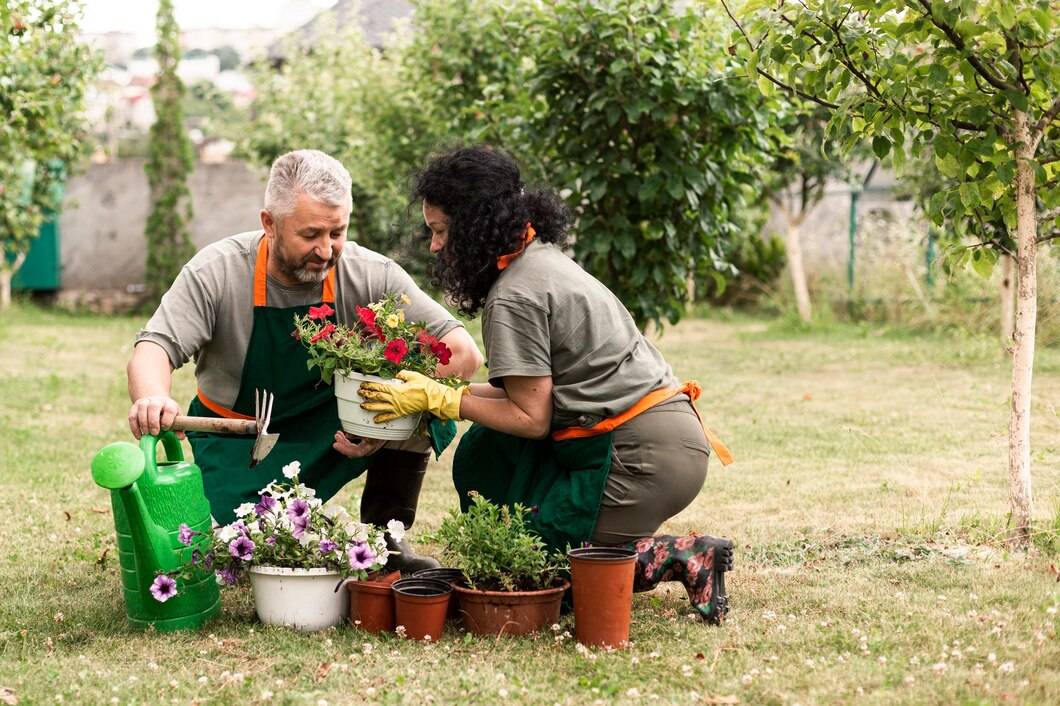Gardening is a year-round endeavor that requires careful planning and understanding of your growing season. One of the keys to successful home gardening is knowing what to plant and when, ensuring that your garden provides a continuous harvest throughout the year. Seasonal gardening allows you to optimize your crops by planting the right vegetables, fruits, and flowers at the correct time for each season.
This guide is designed to help you plan your garden in sync with the changing seasons. Whether you have a small balcony garden or a large backyard plot, you can make the most out of every season by choosing the best plants to grow right now and prepare for future harvests.
In this post, we will break down the key planting months and the types of crops to grow throughout the year. Whether you're a novice gardener or an experienced enthusiast, this guide will help you maximize the productivity of your garden and ensure you always have fresh produce.
Section 1: Understanding the Basics of Seasonal Gardening
Subsection 1.1: What is Seasonal Gardening?
Seasonal gardening is the practice of growing crops that are appropriate for each season. Different plants thrive in different conditions, so understanding the changing climate and temperatures in your region is essential for a successful garden.
There are four distinct seasons to consider when planning your garden: spring, summer, fall, and winter. Each season has its own unique requirements in terms of temperature, rainfall, and daylight, which affects the type of plants that will flourish.
Subsection 1.2: Understanding Your Growing Zone
The first step in any seasonal gardening plan is to understand your USDA Hardiness Zone, which determines the types of plants that are most likely to thrive in your area. Your zone is based on the average minimum winter temperature in your location.
- Zone 1-3: Extremely cold winters, short growing seasons
- Zone 4-6: Cold winters, moderate growing seasons
- Zone 7-9: Mild winters, longer growing seasons
- Zone 10-11: Warm winters, long growing seasons
By understanding your zone, you’ll know the best planting times for each season and avoid planting crops that aren’t suited for your area.
Subsection 1.3: The Concept of Succession Planting
Succession planting is the strategy of planting crops in stages so that as one harvest ends, another is ready to take its place. This method ensures a continuous supply of fresh vegetables and helps maximize the productivity of your garden.
Section 2: Planting for Spring – The Season of Growth
Spring is the time of renewal when the soil warms, and everything begins to grow. It’s a perfect time to plant a variety of crops that will thrive in the cool, moderate temperatures.
Subsection 2.1: Early Spring Crops
In early spring, you’ll want to plant crops that tolerate cooler temperatures. These crops can withstand light frosts and grow well in soil that is still warming up.
Leafy Greens: Lettuce, spinach, arugula, kale, and Swiss chard are ideal for planting early in the season. These crops grow quickly and are well-suited for cooler weather.
Root Vegetables: Carrots, radishes, beets, and turnips are all excellent choices for early spring planting. These root crops prefer cooler soil and will be ready for harvest in a few months.
Peas: Both snap peas and shelling peas can be planted early. These plants prefer cooler temperatures and will produce a sweet, fresh harvest in late spring.
Onions and Garlic: Onions and garlic can be planted as early as the ground can be worked. These crops require a long growing period and will be ready for harvest in late summer or fall.
Subsection 2.2: Late Spring Crops
Once the last frost has passed and the weather warms up, it’s time to plant more heat-loving crops that will thrive in the warmer temperatures.
Tomatoes: Tomatoes are a staple of summer gardens. Choose from heirloom, cherry, or beefsteak varieties based on your preferences and growing space.
Peppers: Both sweet and hot peppers are great to plant in late spring, as they need warmer soil temperatures to thrive.
Cucumbers: Cucumbers grow well in warm soil and produce high yields in the summer months.
Beans: Plant beans such as pole beans or bush beans in late spring for a quick-growing, productive crop.
Section 3: Summer – Thriving in the Heat
Summer is the time when your garden will be in full swing, with most crops at their peak growing season. The longer days and warmer temperatures help plants flourish.
Subsection 3.1: Warm-Season Vegetables
Summer is the season to focus on vegetables that thrive in the heat and can handle the long, sunny days.
Squash and Zucchini: These plants love the heat and produce abundant fruit in summer. Squash and zucchini are perfect for succession planting, as they can be sown in stages to ensure a continuous harvest.
Melons: Watermelons, cantaloupes, and other melons grow well in warm weather and require plenty of space to spread out.
Corn: Corn needs lots of sunshine and space to grow tall. It’s a great addition to any summer garden.
Eggplant: Another heat-loving crop, eggplant thrives in the summer heat and produces fruits that are perfect for grilling, sautéing, and roasting.
Subsection 3.2: Companion Planting for Summer Crops
Certain plants grow better when they are planted next to others. For example:
- Tomatoes and Basil: Planting basil near tomatoes helps repel pests and enhances the flavor of the tomatoes.
- Cucumbers and Corn: Cucumbers can benefit from the shade provided by taller corn plants.
Section 4: Fall – Preparing for Harvest and Winter
As the weather cools, fall is the time to start harvesting and preparing your garden for the colder months. It’s also an excellent season to plant crops that thrive in cooler temperatures.
Subsection 4.1: Fall Vegetables
In late summer and early fall, plant cool-season crops that can grow well as the weather begins to cool.
Broccoli and Cauliflower: These brassicas grow well in the cooler temperatures of fall. They require full sun and plenty of water for optimal growth.
Cabbage: Cabbage can be grown in fall gardens, and it thrives in the cool, crisp weather.
Brussels Sprouts: These plants actually taste better after a light frost, making them perfect for a late-season harvest.
Spinach and Lettuce: Both spinach and lettuce thrive in cooler fall temperatures and can be planted in late summer for a fall harvest.
Subsection 4.2: Fall Garden Care
Mulching: Use mulch to insulate the soil and protect tender plants as temperatures start to drop.
Harvesting: Be sure to harvest fall crops before the first hard frost. Many fall crops like kale, spinach, and lettuce can tolerate light frosts but should be harvested before temperatures drop too low.
Section 5: Winter – Growing in the Cold
Winter gardening is often overlooked, but many gardeners successfully grow crops during the colder months. If you live in a mild climate, winter gardening is a great way to extend the growing season.
Subsection 5.1: Winter Crops
Some crops are well-suited for winter gardening, particularly in areas with mild winters. You can also use indoor growing systems such as greenhouses or hydroponic setups.
Kale: Kale is a hardy vegetable that can survive through the winter months. The cold weather even enhances its flavor.
Carrots: Carrots can be grown in the winter, as long as the soil doesn’t freeze. They can be stored in the ground and harvested as needed.
Garlic: Plant garlic in late fall for a spring or early summer harvest. Garlic needs a long growing season and benefits from the cold.
Herbs: Parsley, cilantro, and thyme are hardy herbs that can be grown indoors or in a mild climate throughout the winter.
Section 6: Indoor Gardening for Year-Round Harvest
If you live in a region with harsh winters, indoor gardening allows you to grow food year-round. Indoor gardens also offer the benefits of controlled environments, minimizing the risks of pests and diseases.
Subsection 6.1: Setting Up Indoor Gardens
Herb Gardens: Growing herbs indoors is easy and requires little space. Consider growing basil, parsley, chives, and thyme on a sunny windowsill.
Hydroponics: Hydroponic gardening is a soil-free method of growing plants using water and nutrient solutions. It’s perfect for indoor gardening and provides fresh vegetables like lettuce, spinach, and herbs all year round.
Grow Lights: If you don't have a sunny spot for your indoor garden, invest in grow lights to provide the necessary light for your plants to thrive.
Subsection 6.2: Maintaining Indoor Gardens
Watering: Be sure to water indoor plants carefully, as overwatering is a common mistake. Use pots with drainage holes and avoid letting plants sit in standing water.
Temperature and Humidity: Indoor gardens need a consistent temperature and humidity level to thrive. Use a thermometer and hygrometer to monitor the conditions.
Conclusion: Year-Round Gardening Success
Seasonal gardening allows you to maximize your garden’s potential by planting the right crops at the right time of year. With careful planning, you can enjoy a continuous harvest, from early spring greens to late fall root vegetables. By understanding your growing zone, following a crop rotation plan, and selecting the right plants for each season, your garden can thrive throughout the year.
Gardening is a rewarding, sustainable practice that connects you to nature and provides fresh food for your home. With the information provided in this guide, you’re now ready to plant with confidence and enjoy a successful, year-round garden.


